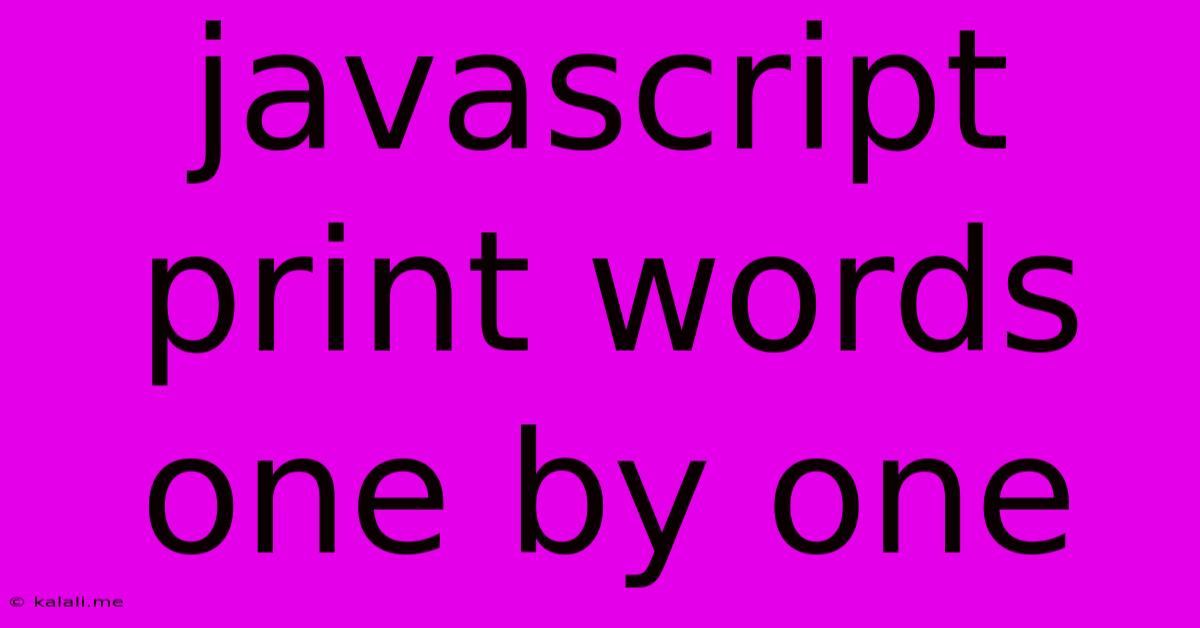Javascript Print Words One By One
Kalali
Jun 01, 2025 · 3 min read

Table of Contents
Printing Words One by One in JavaScript: A Comprehensive Guide
This article explores several methods for printing words from a string one by one in JavaScript, catering to different needs and levels of complexity. We'll cover basic approaches suitable for beginners and delve into more advanced techniques using asynchronous functions for smoother user experiences. Learn how to control the printing speed, add visual effects, and handle potential edge cases. This guide is perfect for anyone looking to enhance their JavaScript skills and create interactive text displays.
Method 1: Using setTimeout for a Simple Approach
The simplest method involves using setTimeout to introduce delays between printing each word. This approach is easy to understand and implement, making it ideal for beginners.
function printWordByWord(text) {
const words = text.split(" ");
let i = 0;
function printNextWord() {
if (i < words.length) {
document.getElementById("output").innerHTML += words[i] + " ";
i++;
setTimeout(printNextWord, 500); // Adjust delay (in milliseconds) as needed
}
}
printNextWord();
}
// Example usage:
const myText = "This is a sample sentence.";
printWordByWord(myText);
This code splits the input string into an array of words, then uses a recursive setTimeout function to print each word with a 500ms delay. Remember to have an element with the ID "output" in your HTML to display the text. You can easily adjust the 500 value to control the printing speed. This method is great for simple scenarios but lacks flexibility for more complex animations.
Method 2: Asynchronous for...of Loop with await and sleep
For a more elegant and readable solution, we can utilize asynchronous programming. This allows for better control and avoids the nested structure of the recursive setTimeout approach.
function sleep(ms) {
return new Promise(resolve => setTimeout(resolve, ms));
}
async function printWordByWordAsync(text) {
const words = text.split(" ");
const outputElement = document.getElementById("output");
for (const word of words) {
outputElement.innerHTML += word + " ";
await sleep(500); // Adjust delay as needed
}
}
//Example usage
const myText2 = "This is another example sentence.";
printWordByWordAsync(myText2);
This method introduces a simple sleep function using Promise to pause execution. The async and await keywords make the code more readable and easier to maintain. This is a preferred method for cleaner code and better control over asynchronous operations.
Method 3: Adding Visual Effects (Typing Animation)
We can enhance the user experience by adding a typing animation effect. This involves simulating the typing process, one character at a time.
async function typeWriter(text) {
const outputElement = document.getElementById("output");
for (let i = 0; i < text.length; i++) {
outputElement.innerHTML += text.charAt(i);
await sleep(50); // Adjust delay as needed
}
}
// Example usage
const myText3 = "This demonstrates a typing animation.";
typeWriter(myText3);
This example adds a character at a time, providing a more dynamic and engaging visual experience. Remember to adjust the delay in sleep() function to fine-tune the typing speed.
Handling Edge Cases and Improvements
Consider these points for more robust code:
- Error Handling: Add error handling for cases where the "output" element might not exist.
- Punctuation: Adjust the word splitting to handle punctuation correctly (e.g., using regular expressions).
- Customizable Delays: Allow users to specify the delay dynamically.
- Styling: Enhance the visual appeal using CSS to style the output text.
By implementing these methods and considering the enhancements, you can create dynamic and engaging text displays in your JavaScript applications. Remember to choose the method that best suits your project's needs and complexity. Experiment with different delays and styling options to achieve the desired effect.
Latest Posts
Latest Posts
-
How To Insert Code In Chatgpt
Jun 03, 2025
-
Is 1 Hour 30 Minutes Layover Enough For Lax
Jun 03, 2025
-
What Challenge Level Is Good For Level 9 Dnd 5e
Jun 03, 2025
-
How Far Can I Drive Without A Coolant Reservoir
Jun 03, 2025
-
Brompton Pump Mounting Problems Bolts Too Short
Jun 03, 2025
Related Post
Thank you for visiting our website which covers about Javascript Print Words One By One . We hope the information provided has been useful to you. Feel free to contact us if you have any questions or need further assistance. See you next time and don't miss to bookmark.